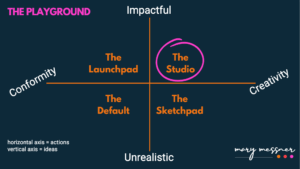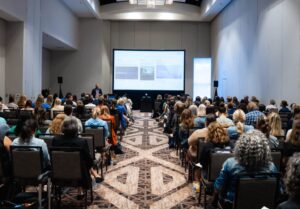Top Takeaways and Inspiring Moments from Raise 2025
Nearly 800 fearless fundraisers came together in San Antonio, Texas, for two days of inspiration, connection, and growth at the ninth annual Raise conference.
From cutting-edge fundraising insights to stories that touched the heart, Raise 2025 delivered big – featuring 50+ industry thought leaders and powerful session tracks on:
- Fundraising Strategy & Donor Engagement
- Event, Peer-to-Peer & Auction Fundraising
- Leadership, Operations & DEI
- Storytelling, Brand & Marketing
Every session, panel, and hallway conversation reflected the passion and innovation driving today’s fundraising community. Let’s explore the top moments from a few sessions and inspiring insights from our Raise 2025 keynotes!
- The Science of Winning Donor Attention in a Distracted World
- Creating Buzz and Bids with Powerful Auction Videos
- Big Ideas for Big Donors
- Keynote Addresses from Dr. Derreck Kayongo and Mary Messner
- Exploring the Future of Fundraising Events
- How Nonprofits Can Harness AI to Save Time, Maximize Impact, and Raise More Funds
- Unlocking Grant Success Through LinkedIn and Instagram
The Science of Winning Donor Attention in a Distracted World
In today’s fast-paced fundraising world, nonprofits aren’t just competing for donations – they’re competing for attention.
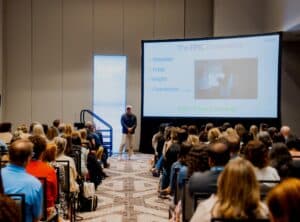
At Raise 2025, Nicholas Kristock, Founder and Executive Director of Fleece and Thank You and KindKatch, brought his energy to a packed room of fundraisers ready to learn how to cut through the noise and connect with donors in meaningful, memorable ways.
He kicked off his session by breaking down how the brain works. First, the gatekeeper receives a message and decides whether to allocate processing power to that message. Then, it determines if that message goes into working memory. In other words, attention isn’t automatic – you have to earn it.
To encourage donors to read messages and follow through with your ask, Nicholas recommends creating peak moments with your organization – a way to attract donor attention all the way. The formula for peak moments includes:
- Sensory details: Put the donor in the scene of your mission through specific details. Specifying that their gift helped purchase “Charlotte’s Web” versus just “books.”
- Personal attribution: Express gratitude directly to the donor. Saying “your $25 gift” rather than “donors like you” shows genuine appreciation.
- Transformative narrative: Define the difficulties that were faced before and the change that their generosity made possible.
- Authentic voice: Let a real person sign your messages. “–Sarah, Director of Donor Engagement, builds trust in a way “Your Nonprofit Team” can’t.
- Break the script: Consider a timing, delivery method, or perspective shift. For instance, starting a text message off with “writing this from Maria’s kitchen table” might catch the donor with an unexpected yet powerful message.
Once you have your donors’ attention, Nicholas shared the EPIC framework, focused on creating community through Elevation, Pride, Insight, and Connection to turn a small spark of interest into a lasting connection.
Creating Buzz and Bids with Powerful Auction Videos
Did you know we retain 80 to 95% of a message when it’s watched as opposed to when it’s read? Erin Kienzle, Founder and Head Auctioneer of Giving4Good, took the mic at Raise 2025 to share her best practices on harnessing the power of video for your mission.
She broke down five video types that grab attention, build emotion, and elevate your next fundraising event:
1. The opener video will play at the beginning of your event. Whether you’re trying to give a general welcome, showcase your mission, or looking for a way to settle down the crowd, an opener video is the perfect way to kick off your event with energy.
2. The live auction video will help to build excitement before bidding begins through:
- A teaser: Give a sneak peek of the auction items attendees can bid on.
- Beautiful visuals: Immerse attendees in the travel and experience packages.
- Voiceovers: Record a video of the auction item with a voiceover of its description.
- Special guests: Invite beneficiaries to make an appearance, showcasing your items.
3. The mission moment video comes before your paddle raise and should evoke shock, curiosity, or another raw emotion. The format should define a problem, highlight a solution, and clearly show how donor support will close that gap.
4. Videos within the paddle raise are not needed for every level – but a short, meaningful clip can connect a specific dollar amount to the real people your donors are helping, making generosity more personal.
5. Lastly, a social media video will get your supporters excited with an auction item preview and sharing the fundraising goal they’d help reach. During your event, capture candid moments or quick interviews to create recap videos that supporters can share afterward.
Erin’s message was clear: when you bring your mission to life through video, you do more than tell your story – you show it. And that’s what makes it unforgettable!
Big Ideas for Big Donors
Major gifts require intentionality and effort in building a long-term relationship rooted in a shared purpose. Bill Stanczykiewicz from the Indiana University Lilly Family School of Philanthropy shared what truly drives transformational giving during his session at Raise 2025.
Bill introduced the concept of a major gift mindset, one focused on a long-term relationship over short-term results. Unlike with an annual fund, which prioritizes volume and frequency, major gifts grow through intentional engagement and genuine connection.
Here’s a breakdown of their key differences:
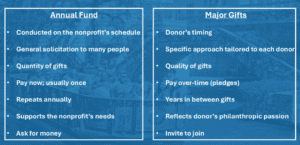
When focusing on major gifts, success isn’t luck – it’s the natural outcome when three essential forces align:
- The nonprofit’s mission and vision
- The fundraiser’s cultivation and stewardship
- The donor’s philanthropic passion and values
The key to successful outreach for big gifts is recognizing when donors are in their “prime time” to give. If you feel that you’ve developed a strong relationship with a donor who might have expressed interest in increasing their generosity, then be prepared to work together to do more for your mission.
To help donors reach that point, nonprofits should:
- Intentionally seek to deepen the relationship
- Make an effort to build trust
- Strengthen emotional connection
- Encourage greater “financial equity”
An impactful takeaway from Bill’s session is the emphasis on co-creating big ideas. True partnership happens when fundraisers and donors dream together – shaping bold visions through mutual commitment. When dedication flows both ways, major gifts become not just possible, but inevitable.
Keynote Addresses from Dr. Derreck Kayongo and Mary Messner
Raise 2025 was filled with inspiration, driven by the powerful words of keynote speakers, Dr. Derreck Kayongo and Mary Messner.
Day 1: Turning Observation into Impact
Kicking off the conference, Dr. Derreck Kayongo, Founder of Global Soap Project and Clean Production Action, shared his remarkable journey from refugee to entrepreneur who turned innovative problem-solving into a lasting impact.
What began as a simple observation – bars of unused hotel soap being discarded – sparked a global movement to recycle soap and improve hygiene access for millions.
His message was clear: small moments of awareness, combined with determination and collaboration, can lead to extraordinary change.
When somebody believes in you and gives you a chance, you are then able to take that chance to do remarkable things.”
Dr. Derreck reminded fearless fundraisers to think about the positive legacy they can leave through their work in the nonprofit sector.
We tell stories that impact people’s lives.”
He closed his keynote address with a SELF takeaway: Serve first to become educated about a problem, then become a leader who has faith and believes in a purpose.
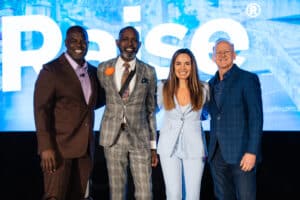
Day 2: Where Creativity Meets Collaboration
On Day 2, Mary Messner, Founder & CEO of the Highland Creative Group, challenged attendees to embrace creativity not just as inspiration, but as a discipline that fuels innovation.
Creativity – it is the ability to think differently, and it is where possibilities begin.”
Mary introduced the Playground framework, a grid that represents four zones of creative operation:
- The Launchpad: You’re focused, trustworthy, and know how to make things work – and while you might not reach big ideas often, when you do, they’re built to last.
- The Default: You’re steady and choose not to shake things up because you believe they work just fine.
- The Sketchpad: You have bold ideas, but they are not quite fully formed. A space for early-stage thinking.
- The Studio: You’re not just dreaming, you’re doing it. It’s the intersection between ideas and action.
Mary’s challenge to attendees? Move into The Studio – the place where imagination meets execution.
If every single person had the skills to be able to stretch into the studio, think about the impact you can make.”
Her parting advice was refreshingly simple yet profound: creativity grows when we invite others in. A simple “help me think through this” question can open doors to collaboration and breakthrough solutions. When we create space for others to join our process, we unlock greater possibilities.
Exploring the Future of Fundraising Events
Led by Emily Newberry, VP of Strategic Accounts at OneCause, a powerhouse panel of fundraising experts discussed how the events landscape is evolving and how nonprofits can adapt. Panelists included:
- Darren Port, CEO & Founder of Powered by Professionals
- Daniel Morford, Sr. Director of Marketing & Events at The Pando Initiative
- TiWanna Kenney, Founder & Principal of Astounding Auctions
- T. Clay Buck, Founder & Principal of Next River Fundraising Strategies
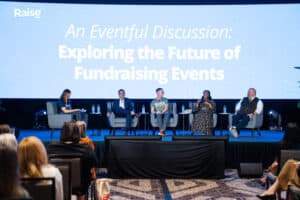
The discussion began with Darren reminding us that “the most important component of fundraising and events is people.” Events remain a cornerstone of fundraising, not because of tradition but because of their unique way to bring people together.
At the same time, how we plan and execute those events is shifting, shaped by donor expectations and new technology. What worked five years ago may no longer resonate, so understanding your audience is necessary for success. As T. Clay put it,
The world has changed, and we need to change with it.”
Understanding your audience – who they are, what they value, and how they want to engage – is key to that evolution. As Emily noted, “Your donors are consumers and your consumers are donors.”
When it comes to the giving experience, simplicity matters. “If they [donors] have to click six times, I guarantee you by the third time, they’ve already left, and they’re no longer engaged,” shared TiWanna, emphasizing the importance of frictionless giving.
A seamless, engaging event experience doesn’t just happen – it’s intentional. Choosing a fundraising platform that doesn’t just simplify giving but also boosts engagement is the key to raising more.
You have to make the investment to make it a good, engaging event,” says Daniel.
The panel’s deep dive into fundraising events ended with a clear takeaway: events aren’t just opportunities to raise money – they’re moments to build momentum for your mission. When designed with people, purpose, and experience at the center, they remind donors why they give – and inspire them to keep giving.
How Nonprofits Can Harness AI to Save Time, Maximize Impact, and Raise More Funds
Chris Strom, Chief Marketing Officer at Sunrise Association, joined us at Raise 2025 to explore the growing role of artificial intelligence (AI) in nonprofit fundraising.
Chris began with a practical framework for crafting high-quality prompts to get better, more tailored responses from AI. His CRAFT model breaks down how to write effective prompts:
- Context: The situation or background information
- Role: Who the AI should act as
- Action: The specific task you want done
- Format: How you want the result presented
- Tone: The style or voice you want it written in
By following the CRAFT model, fundraisers can turn generic responses into thoughtful, ready-to-use content. Chris went on to share how AI can serve as a powerful partner in fundraising efforts:
- Create your AI doppelgänger: Provide writing samples for AI to learn your tone, structure, and vocabulary, helping draft future communications that sound like you.
- Use AI as a second brain: Brainstorm ideas, refine strategies, and turn concepts into action through interactive learning.
- Communication: From drafting donor emails to writing compelling stories, AI can be your creative partner for communicating effectively with supporters.
- Data analytics: Analyze campaign data and identify what worked well or underperformed with the help of AI. (Just be sure to remove sensitive information and double-check the results.)
Chris closed out his session with practical examples of how AI can support nonprofit teams beyond fundraising, including staff training, writing grant proposals, research, and even role-playing with donors. His message to a room full of fearless fundraisers was that AI isn’t here to replace fundraisers, it’s here to enhance our work.
Unlocking Grant Success Through LinkedIn and Instagram
Christina Jones, Chief Executive of External Relations at BWJP, took the Raise 2025 stage to share how nonprofit leaders can turn social media engagement into real fundraising opportunities.
With its powerful algorithm and professional focus, LinkedIn can build trust faster than other social platforms when used intentionally.
People invest in leaders,” Christina reminded us. “Your profile should say: I’m winning and so is my mission.”
One of the first places funders look when researching grant applicants is LinkedIn. To make your grant application stand out, Christina offered these practical ways to turn your LinkedIn profile into a grant-winning tool:
- Understand how the algorithm works: LinkedIn’s purpose is to keep users engaged, so value-driven, professional content tends to perform best.
- Build your digital reputation: Share thought leadership pieces and testimonials to increase credibility. Use a professional tone and polished format to elevate your mission.
- Leverage your personal profile to boost your mission: People respond to people, so make your profile say, “I’m winning and so is my mission.”
To maximize your visibility with funders, Christina suggested creating a content strategy that outlines your goals, what content you already have and need, and how to involve your communications team.
Strategic tagging, like mentioning funders in event recaps and thanking them in the comments, is a way to grow your reach and exposure. Even commenting on a funder’s post or sliding into their DMs professionally can help you catch their eye.
Know who you’re targeting. Research your funders like your mission depends on it, because it does.”
Christina’s session emphasized that grant success isn’t only written in proposals, it’s earned through ongoing visibility, trust-building, and strategic engagement.
That’s a Wrap!
The Raise Conference goes beyond inspiring keynotes and engaging sessions – it’s all about enhancing YOUR impact.
Want to relive moments from Raise 2025? Explore a curated selection of breakout sessions, expert panels designed to spark fresh ideas, practical strategies, and more with our Raise on-demand sessions. And be sure to check out our resource, Top Fundraising Conferences This Year, to explore other conferences to elevate your fundraising expertise.


